There’s an Art Deco Airport Lying Ruined in Brooklyn
Luckily, dedicated volunteers have been restoring the beautiful planes.
Howard Hughes arrives at Floyd Bennett Field. (Photo: Bettmann/Getty Images)
On the far reaches of Brooklyn’s Atlantic coastline is a forgotten piece of aviation history.
Long before JFK and LaGuardia, there was Floyd Bennett Field, New York City’s first municipal airport. Designed in stunning Art Deco style, it was once the most modern airport in the world, a glittering gateway into America’s principal metropolis. Many of the leading aviators of their day started daring adventures here during the golden age of aviation—pilots like Amelia Earhart, Charles Lindbergh and Roscoe Turner, the latter of whom flew with a lion cub as his co-pilot. Wiley Post, the man who was the first to fly solo around the world, took off and landed here in front of crowds of 50,000 fans. When Howard Hughes set the world record for flying fastest around the world, it was from Floyd Bennett that he piloted his gleaming Lockheed Super Electra.
But today many of the old hangars lie empty and abandoned. The deserted control tower looks over runways covered in weeds. I went to explore the airfield to discover its incredible history, uncovering a remarkable hidden treasure along the way—a graveyard of vintage planes being tended to by a dedicated group of volunteers.

One of Brooklyn’s best kept secrets, Hangar B, filled with vintage aircraft being restored. (Photo: Luke Spencer)
When it opened in 1931, Floyd Bennett Field was the most advanced and sophisticated airport in the United States. Named for pioneering aviator and Brooklyn resident Floyd Bennett, who won the Congressional Medal of Honor in 1926 for flying to the North Pole, the modern airfield was at the forefront of the fledging air travel industry.
Floyd Bennett was built on what was then the marshlands around Jamaica Bay in an area called Barren Island. Located roughly a dozen miles from Manhattan, Barren Island was once home to a small community of fish processing factories. It had a main street, a church and even a hotel. Roughly six million tons of landfill created the foundations for the new airport.

Many of the Art Deco styled hangars lie empty and abandoned. (Photo: Luke Spencer)
The focal point of the roughly 1,400-acre airport was a beautiful terminal, which is still there today. Designed in the Art Deco style with classical Doric columns, it was a suitably grand airport for New York City. In the 1930s air travel was still largely enjoyed only by the wealthy, and well-dressed passengers would arrive at the sweeping drive way in front of the terminal where their luggage was collected by porters and taken underground by twin ramped tunnels which emerged out on the runway. The inside of the terminal was decorated with vast, elaborate murals from the WPA program.
The Art Deco interior housed a ticketing office, a restaurant (the Aviator Bar & Grill), a newsstand, barbershop, photo studio and even a radio studio to broadcast commentaries of the world record attempts that took place here. After checking in, passengers could retire to a cocktail bar that led onto balconies overlooking the airfield, and runways that were amongst the first to be concreted and lit electrically.
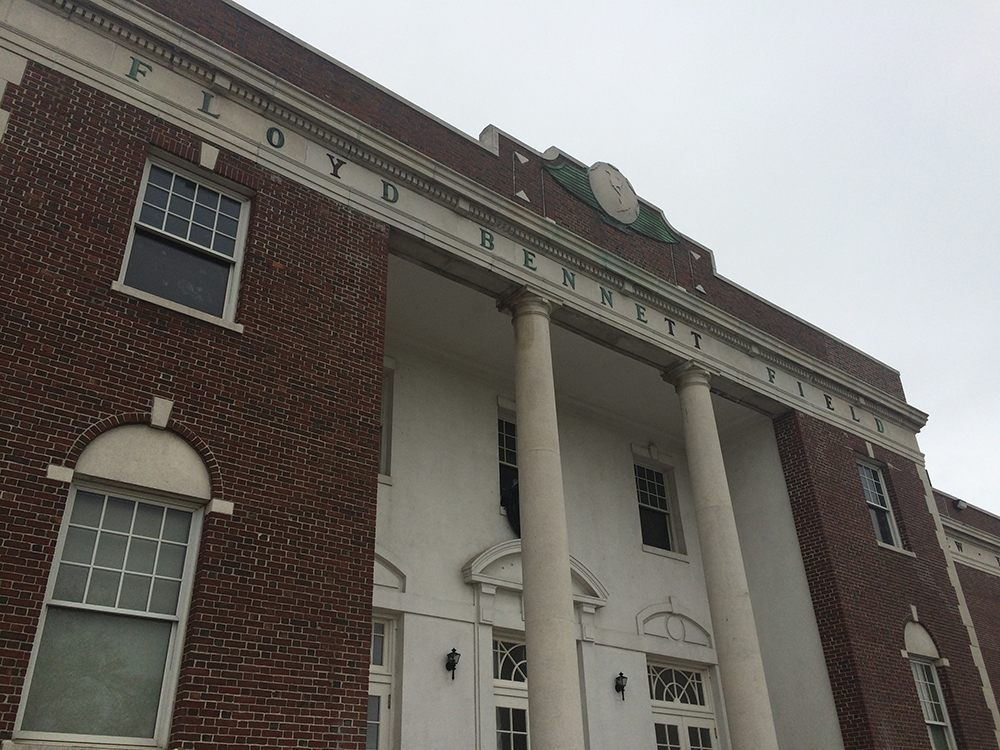
The main terminal was the height of luxury air travel when it opened. (Photo: Luke Spencer)
Today, thanks to the National Park Service who took control of the airfield in the 1970s, the ground floor of the terminal has been recently restored to much of its original elegance. A small museum tells the story of the airfield and the famous aviators who once flew from here.
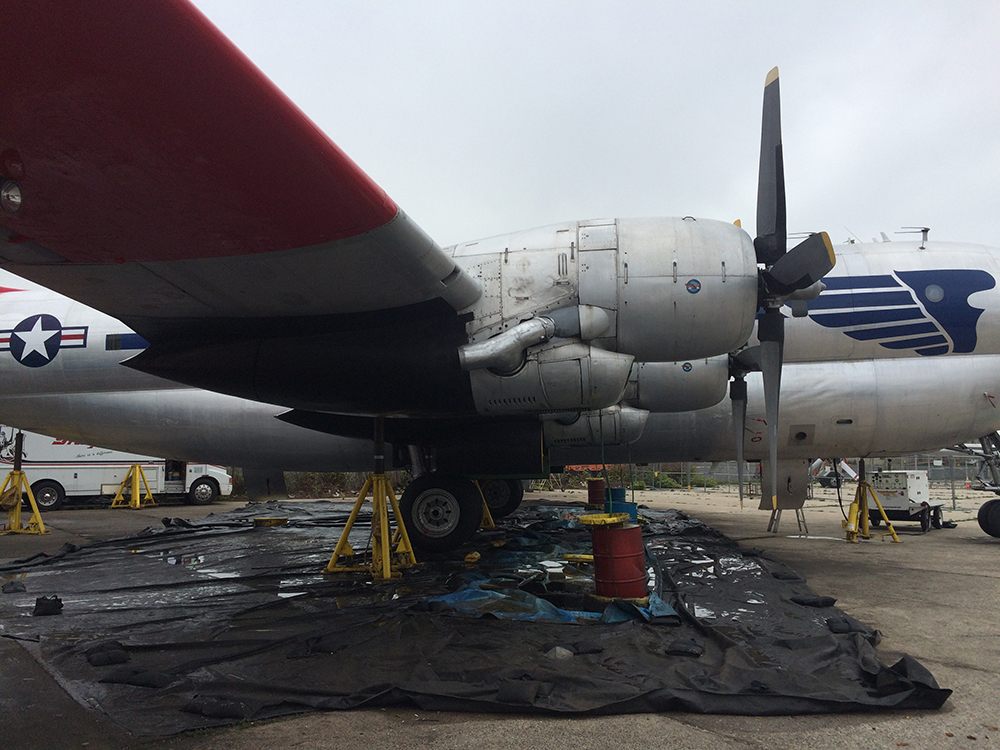
One of the last long range propeller aircraft, the C-97 was soon eclipsed by the jet age. (Photo: Luke Spencer)
But upstairs much of the terminal is sadly falling apart. These were once the pilots quarters, where aircrew could rest and office. Peeling paint, empty bedrooms and cracked bathroom tiles are all that remain. Up a narrow ladder is the control tower. All the instruments are long gone, but the views over the mostly abandoned airfield and Marine Park are captivating. “We’re about as far out in Brooklyn as you can get,” says a ranger from the National Park Service. “It is remote enough today, let alone in the 1930s and 40s for a viable passenger terminus.”
That remoteness was its downfall. A new tunnel built in 1940 connecting Queens to midtown Manhattan led the way for a much more convenient airport to be built on the site of the old Gala Amusement Park in northern Queens. Named for the city mayor who championed its development, LaGuardia airport effectively marked the end of Floyd Bennett as New York’s principal airport.

Aerial view of Floyd Bennett Field in the 1940s. (Photo: U.S. Navy National Museum of Naval Aviation/Public Domain)
During World War II, much of Floyd Bennett Field become a Naval Air Station. The runways and roads inside the base were extended and new buildings were constructed for sleeping quarters, munitions, gymnasiums, and even ballfields. Most of the infrastructure from that period today is still used by the Coast Guard and the NYPD, but many of the buildings today lie empty. Mechanics facilities, dormitories and offices are covered in ivy, full of rusted equipment and left for nature to reclaim.
When the National Park Service acquired Floyd Bennett in 1971, it became part of their Gateway National Recreation Area. A vast program encompassing Sandy Hook in New Jersey, Fort Tilden and Riis Park in Queens and much of Jamaica Bay amongst others, Floyd Bennett became protected wildlife preserve. Nature was allowed to reclaim parts of the runway, and community gardens were recreated. There is even a campsite, one of New York’s largest, named after Amelia Earhart, allowing campers the unusual experience of spending the night on an old deserted airfield, by the water where once seaplanes took off and landed.
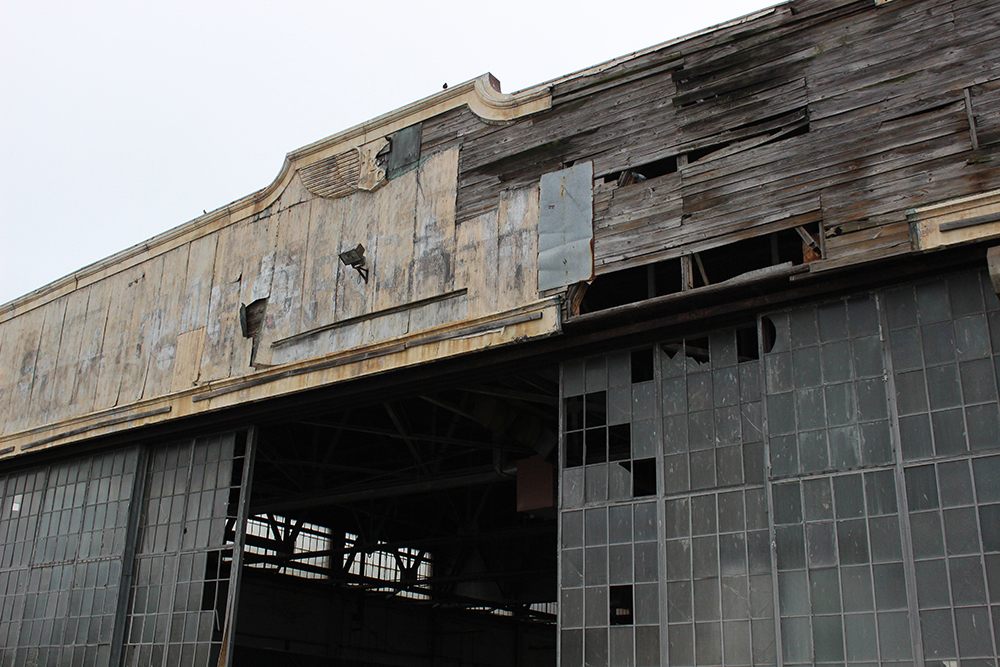
When Howard Hughes set the world record for flying around the world, thousands flocked to Floyd Bennett. (Photo: Luke Spencer)
At the far end of the airfield, some ten minutes walk across the abandoned runways lies one of Brooklyn’s best kept secrets. A hangar swiftly built in the Second War, inside is a remarkable plane graveyard, known as Hangar B. Home to a dozen rescued vintage planes, the drafty cavernous hangar is filled with seaplanes, biplanes, fighters and cargo freighters. Some are in better shape than others, who await restoration.
Hangar B is headquarters for several groups of dedicated volunteers. Often retired, ex-Air Force mechanics, or simply history buffs, these veteran plane enthusiasts are steadily keeping the true spirit of Floyd Bennett Field alive. The principal group is known as the Historic Aircraft Restoration Project (HARP), which meets here three times a week. One long-serving volunteer named Artie Kuhnert shows me a hulking old flying boat known as a PBY Catalina. “It was found at the end of a runway in Brazil about thirty five years ago, right in the middle of the rainforest,” he says. According to Kuhnert, it had been leased to the Brazilian government during World War II for just $1—its mission, to patrol the waters of the Brazilian coastline for German U-boats. As we climbed into the seaplane, rescued from the rainforest, walking down the bare steel skeleton of the fuselage and into the old cockpit, Kuhnert told me how is still belongs to the Navy, but the Parks department arranged to bring it in pieces to Floyd Bennett to be restored.
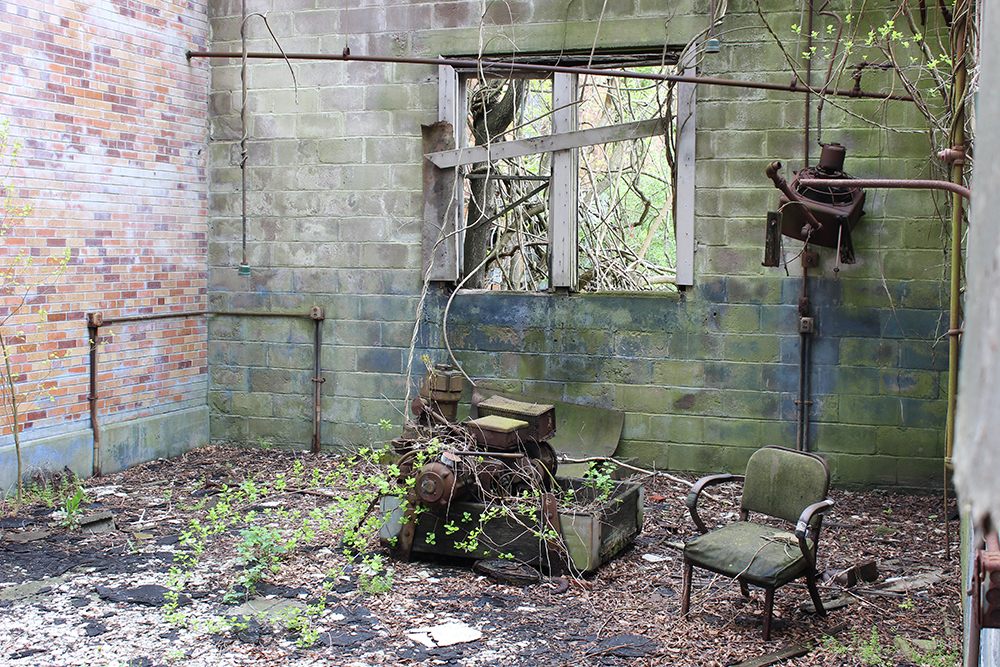
The abandoned mechanics workshop. (Photo: Luke Spencer)
We walk past an old AT6 trainer plane, painted black with a snarling red mouth and bared teeth, whose wings are unattached and leaning against the fuselage, to a striking yellow biplane, restored to its 1940s polish—a project that took three years to complete. Kuhnert leads the way into a C47, the legendary transport aircraft that was developed from the Douglas DC3. These were the planes that fought at Guadalcanal, dropped supplies to the soldiers trapped at Bastogne during the Battle of the Bulge and dropped paratroopers behind the Normandy beaches. As we climb into the plane you can still see the cable running along the ceiling that when ordered by the jump sergeant, paratroopers would hook onto. Like a lot of the aircraft in Hangar B, the C47 needs further restoration.
Another volunteer, Dante DiMille, flew reconnaissance missions for the air force in the Korean War. “I was shot at but never fired back,” he tells me. In the Hangar B mess hall he shows me a photograph of himself as a young man and then points out one of the planes the HARP volunteers are most proud of—an exact replica of Wiley Post’s Lockheed Vega, the Winnie Mae.

Inside the cockpit of the Boeing Stratofreighter on the day the volunteers tested the landing gear. (Photo: Luke Spencer)
In 1933, the one-eyed aviator set the world record for flying around the world solo, going round trip through Floyd Bennett Field. The original Winnie Mae can be found at the Smithsonian in Washington DC, but according to DiMille, “it belongs here because it made the flight from here.” So the HARP veterans decided to make their own. No thanks to the museum (“The Smithsonian wouldn’t give us anything”) they took a toy model airplane kit of the Winnie Mae and enlarged the instruction plans to build an exact scale replica, a labor of love that spanned six years.
But despite the rich aviation history of Floyd Bennett Field, it remains largely unknown and ignored not only by the Smithsonian but also by the City of New York. “No one really knows what to do with it,” DiMille explains, noting that some of the hangars were converted to a sports center, but not much else. “One of our biggest problems is we’re old people. The skills it takes to restore old aircraft, they don’t exist anymore.”
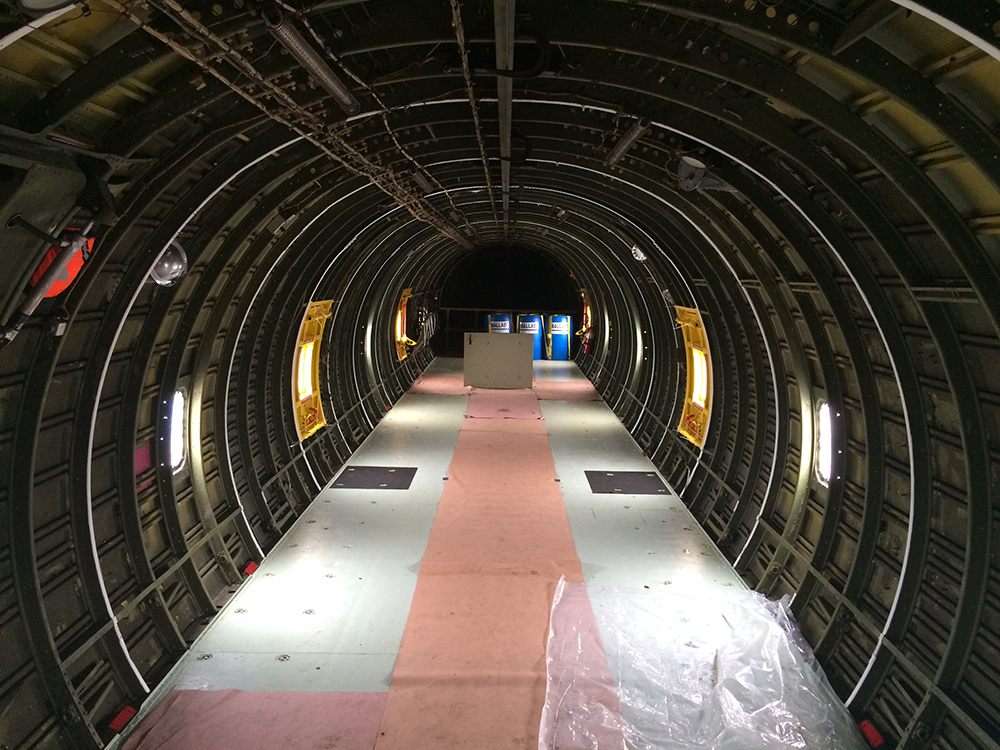
It was planes like these that saved Berliners during the airlift. (Photo: Luke Spencer)
Hangar B itself was in a fair state of disrepair when I first visited in the winter of 2013, with broken windows and holes in the roof. In the intervening time, Hurricane Sandy had wreaked terrible damage to the 70-year-old hangar, and it eventually had to close its doors temporarily for desperately needed repairs.
Returning to Floyd Bennett Field recently, I saw fences encircling Hangar B, where the plane graveyard still rests inside, and which is due to hopefully reopen in the summer of 2016. But behind the hangar, one plane is still being worked on. It sits out on the forecourt runway, an awe-inspiring piece of machinery from the end of the early days of the Cold War. Around 110 feet long, with a wing span of over 140 feet of gleaming silver steel and chrome, it’s a Boeing C-97, with the suitably magnificent name the “Stratofreighter”. These giant propeller planes were used during the Berlin airlift and the wars in Korea and Vietnam and could transport an astonishing 35,000 pounds of cargo. The one being worked on at Floyd Bennett Field is one of only two still airworthy today.
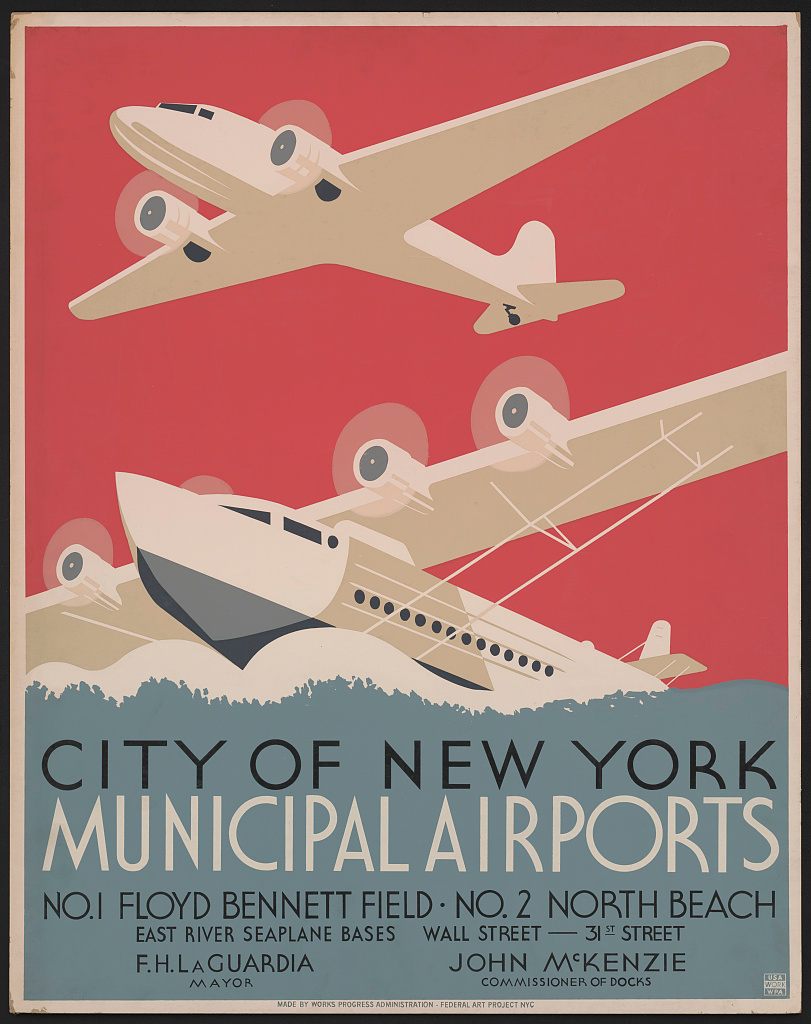
A 1930s-era poster for Floyd Bennett Field. (Photo: LC-DIG-ds-08069/Library of Congress)
Nicknamed the “Angel of Deliverance,” it has led a storied life after the war, flying relief missionary work in South America and hauling salmon in Alaska. Tim Chopp, an ex-air force mechanic who served in Vietnam leads the group of dedicated volunteers. “Our aim is to preserve the memory and legacy of one of the greatest aviation and humanitarian efforts in history,” he says. Between June 1948 and September 1949, the U.S. and Great Britain airlifted desperately needed supplies to the half of Berlin entirely surrounded by the Iron Curtain. The Berlin airlift was the deadly focal point of the Cold War conflict.
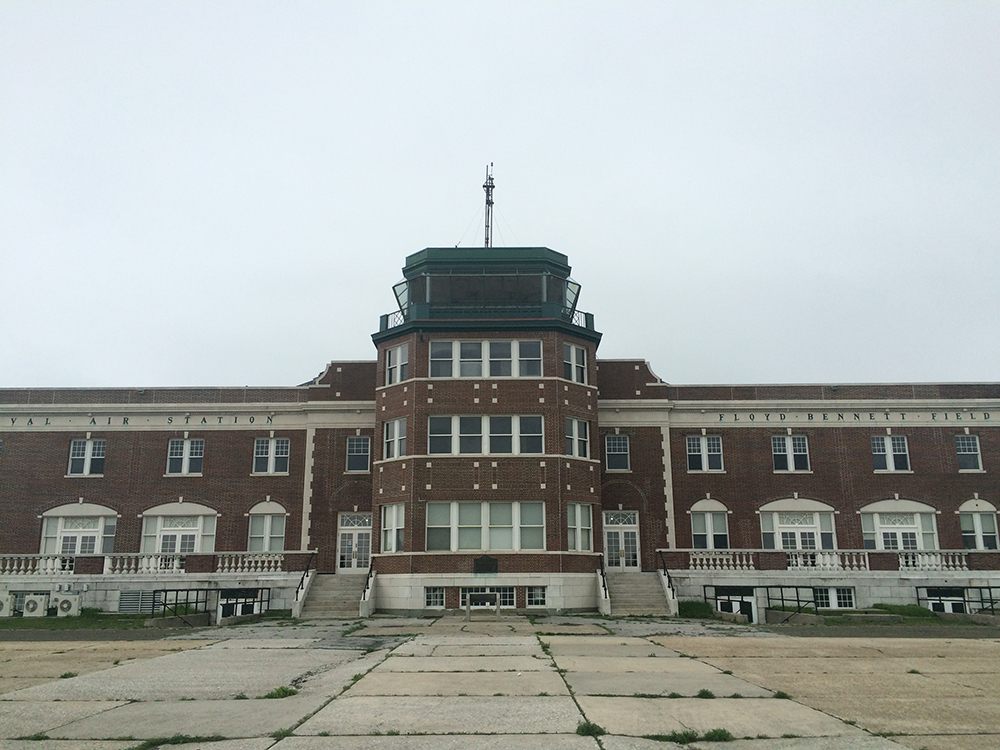
New York’s first municipal airport, Floyd Bennett’s fate was sealed with the opening of LaGuardia. (Photo: Luke Spencer)
With Floyd Bennett’s future uncertain, the plan is to fly the Angel of Deliverance to New Jersey. Like the HARP group, the dozen or so Deliverance volunteers receive no funding from official museum sources; some of the team has been working on the plane for over 12 years. When I visited, they were testing the hydraulics on the landing wheels. Gently raising the 82,500 pound plane on oversized jacks, the small group worked on retracting the huge wheels over and over.
One of the volunteers monitoring the precarious operation knows this plane better than anyone. Master mechanic Berge Jermakian made these planes fly in the Korean War and commercially for Northwestern Airlines. The biggest challenge is paying for fuel, he explained. “We need about 15,000 gallons, and no one really knows we’re here.”



















Follow us on Twitter to get the latest on the world's hidden wonders.
Like us on Facebook to get the latest on the world's hidden wonders.
Follow us on Twitter Like us on Facebook